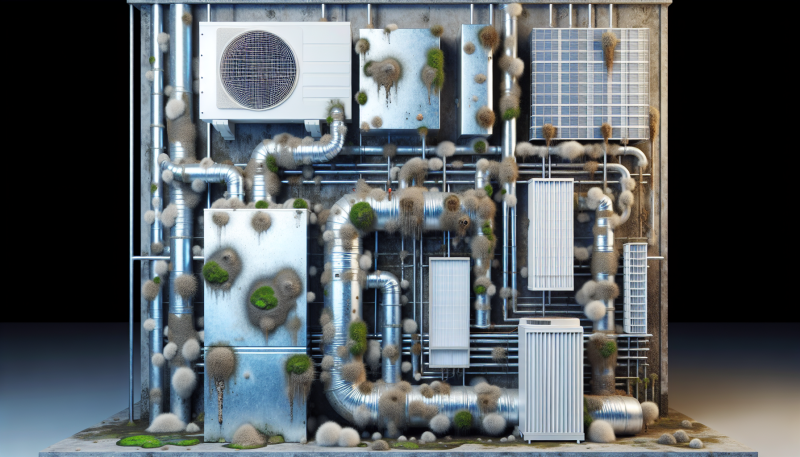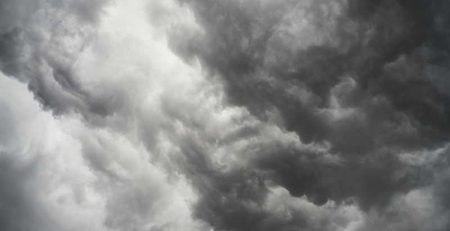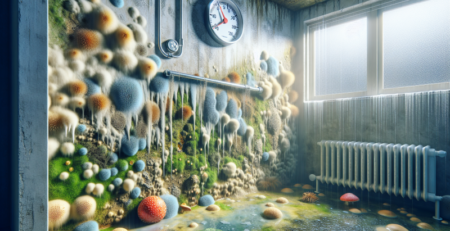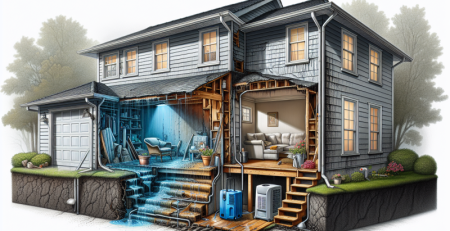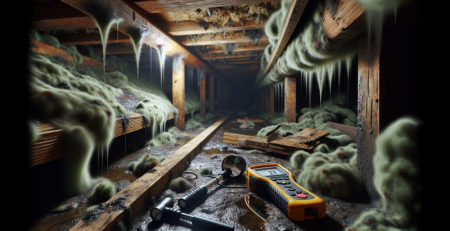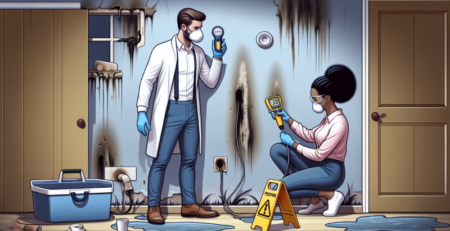Mold in Your HVAC System: What to Do
Mold in your HVAC system can pose serious health risks and compromise the air quality in your home. At Kraus Restoration, NJ’s leaders in water, mold, and fire damage restoration, we understand the urgency of addressing mold issues promptly. Our IICRC certified experts are available 24/7 to provide rapid response and effective solutions for Central and Northern NJ residents. In this blog, we’ll guide you through the steps to identify, prevent, and eliminate mold in your HVAC system, ensuring a healthier living environment. For immediate assistance, call us at (973) 886-2021.
Understanding Mold in HVAC Systems
Mold in HVAC systems is a common yet often overlooked issue that can have significant implications for both health and property. Understanding how mold develops in these systems, its potential impacts, and the steps to mitigate it is crucial for maintaining a healthy indoor environment.
Mold thrives in environments with excess moisture, and HVAC systems can provide the perfect breeding ground. When the system cools the air, it also removes moisture, which can accumulate in the ducts, filters, and other components. Over time, this moisture can lead to mold growth, especially if the system is not regularly maintained. According to the Environmental Protection Agency (EPA), "indoor air quality is one of the top five environmental risks to public health," and mold is a significant contributor to poor indoor air quality.
The presence of mold in HVAC systems can lead to various health issues, particularly for individuals with allergies, asthma, or weakened immune systems. Symptoms can range from mild irritation to severe respiratory problems. The Centers for Disease Control and Prevention (CDC) notes that "exposure to damp and moldy environments may cause a variety of health effects, or none at all." Therefore, it is essential to identify and address mold issues promptly.
Several factors contribute to mold growth in HVAC systems:
- Poor Ventilation: Inadequate ventilation can trap moisture within the system, creating a conducive environment for mold.
- Dirty Filters: Filters that are not regularly cleaned or replaced can accumulate dust and moisture, promoting mold growth.
- Leaky Ducts: Leaks in the ductwork can introduce moisture and contaminants, leading to mold proliferation.
- High Humidity: Areas with high humidity levels are more prone to mold issues, as the excess moisture can easily infiltrate the HVAC system.
To prevent mold growth in HVAC systems, regular maintenance is key. This includes cleaning and replacing filters, ensuring proper ventilation, and inspecting the system for leaks or other issues. Professional HVAC cleaning services can also help in thoroughly cleaning the system and removing any mold present. For more information on professional mold cleanup services, you can visit our mold cleanup page.
If you suspect mold in your HVAC system, it is crucial to address it immediately. Ignoring the problem can lead to more severe issues, including extensive property damage and health risks. Here are some steps to take if you suspect mold in your HVAC system:
- Turn off the HVAC system to prevent further spread of mold spores.
- Inspect the system for visible signs of mold, such as discoloration or a musty odor.
- Contact a professional HVAC technician to assess and clean the system. You can reach out to us through our contact page for expert assistance.
- Consider installing a dehumidifier to control humidity levels and prevent future mold growth.
- Regularly maintain your HVAC system to ensure it remains clean and free of mold.
In addition to professional cleaning, there are several preventive measures homeowners can take to reduce the risk of mold in their HVAC systems. These include:
- Using high-efficiency particulate air (HEPA) filters to capture mold spores and other contaminants.
- Ensuring proper drainage of the HVAC system to prevent water accumulation.
- Regularly inspecting and cleaning air ducts and other components of the system.
- Maintaining indoor humidity levels below 60 percent to inhibit mold growth.
Understanding the importance of mold prevention and maintenance in HVAC systems can save homeowners from costly repairs and health issues. For more detailed information on our services, please visit our services page.
In conclusion, mold in HVAC systems is a serious issue that requires immediate attention. By understanding how mold develops, its potential health impacts, and the steps to prevent and address it, homeowners can ensure a healthier indoor environment. Regular maintenance and professional cleaning are essential in keeping HVAC systems mold-free. For more information on how we can help, please visit our about page.
Common Causes of Mold Growth
Mold growth in HVAC systems is a common issue that can lead to a variety of health problems and structural damage if not addressed promptly. Understanding the common causes of mold growth is crucial for prevention and maintenance. One of the primary causes is moisture, which can accumulate in HVAC systems due to condensation, leaks, or high humidity levels. When moisture is present, it creates an ideal environment for mold spores to thrive. Poor ventilation is another significant factor; inadequate airflow can cause moisture to linger, further promoting mold growth. Additionally, dirty filters and ducts can harbor mold spores and other contaminants, which can then spread throughout the system. Regular maintenance, including cleaning and replacing filters, is essential to prevent this buildup. Another contributing factor is the presence of organic materials such as dust, dirt, and debris, which provide a food source for mold. Ensuring that your HVAC system is clean and free of such materials can help mitigate the risk. It’s also important to address any structural issues, such as leaks or cracks, that could allow moisture to enter the system. For more information on how to handle mold issues, you can explore our mold cleanup services. If you need professional assistance, don’t hesitate to contact us for expert advice and solutions. Regular inspections and maintenance are key to keeping your HVAC system mold-free and ensuring a healthy indoor environment.
Signs and Symptoms of Mold in Your HVAC
Mold in your HVAC system can pose significant health risks and compromise the efficiency of your heating and cooling systems. Recognizing the signs and symptoms of mold growth is crucial for maintaining a healthy indoor environment. One of the most common indicators is a musty or earthy odor emanating from your vents. This smell is often more pronounced when the HVAC system is running. Another telltale sign is visible mold growth around the air ducts, drip pans, or other components of the HVAC system. You might also notice an increase in allergy-like symptoms among household members, such as sneezing, coughing, and eye irritation, which can be exacerbated by the circulation of mold spores through the air. Additionally, if you observe an unexplained spike in respiratory issues or asthma attacks, it could be linked to mold exposure. It’s also worth noting that mold can cause damage to the HVAC system itself, leading to reduced efficiency and higher energy bills. Regular maintenance and inspections can help identify these issues early. If you suspect mold in your HVAC system, it’s essential to address it promptly to prevent further health risks and damage. For professional assistance, consider reaching out to experts who specialize in mold cleanup. You can learn more about our comprehensive services by visiting our about page or contact us directly for a consultation.
Health Risks Associated with HVAC Mold
Mold in your HVAC system can pose significant health risks to you and your family. When mold spores are present in your heating, ventilation, and air conditioning system, they can be distributed throughout your home, leading to a variety of health issues. One of the most common problems associated with HVAC mold is respiratory complications. Individuals with asthma, allergies, or other pre-existing respiratory conditions may experience exacerbated symptoms such as coughing, wheezing, and shortness of breath. Even healthy individuals can develop respiratory issues after prolonged exposure to mold spores.
In addition to respiratory problems, mold exposure can cause other health concerns. Skin irritation, including rashes and itching, is a frequent complaint among those exposed to mold. Eye irritation, characterized by redness, watery eyes, and itching, is another common symptom. Mold exposure can also lead to sinus congestion, headaches, and fatigue, making it difficult to carry out daily activities. In more severe cases, individuals may experience chronic conditions such as bronchitis or develop fungal infections, which can be particularly dangerous for those with weakened immune systems.
The presence of mold in your HVAC system can also impact your overall indoor air quality. Poor air quality can lead to a range of health problems, including dizziness, nausea, and even cognitive issues such as difficulty concentrating. Children, the elderly, and individuals with compromised immune systems are especially vulnerable to the adverse effects of poor indoor air quality caused by mold.
To mitigate these health risks, it is crucial to address mold issues in your HVAC system promptly. Regular maintenance and cleaning of your HVAC system can help prevent mold growth. If you suspect mold in your HVAC system, it is essential to seek professional assistance. Companies like Kraus Restoration offer specialized mold cleanup services to ensure your home is safe and mold-free. For more information on how to protect your home and health, you can visit their about page or contact them directly. Taking proactive steps to address mold in your HVAC system can significantly improve your indoor air quality and safeguard your health.
How to Inspect Your HVAC System for Mold
Inspecting your HVAC system for mold is a crucial step in maintaining a healthy indoor environment. Mold can cause a variety of health issues, including respiratory problems and allergic reactions, so it’s essential to identify and address any mold growth promptly. Begin by turning off your HVAC system to ensure safety during the inspection. Start with a visual examination of the air ducts, vents, and filters. Look for visible signs of mold, such as black, green, or white spots, and check for any musty odors that could indicate mold presence. Pay special attention to areas where moisture is likely to accumulate, such as near the cooling coils, drip pans, and condensate lines.
Next, remove and inspect the air filters. Dirty or damp filters can be a breeding ground for mold. If you find mold on the filters, replace them immediately. It’s also a good idea to check the insulation around the ducts for any signs of mold or moisture damage. Use a flashlight to inspect the interior of the ducts as thoroughly as possible. If you notice any mold growth, it’s advisable to contact a professional for a more comprehensive inspection and cleaning.
Additionally, consider using a moisture meter to detect hidden moisture within the HVAC system, as mold thrives in damp environments. Regular maintenance, such as cleaning and replacing filters and ensuring proper drainage, can help prevent mold growth. For more detailed guidance on mold inspection and remediation, you can explore the mold cleanup services offered by Kraus Restoration. If you need professional assistance, don’t hesitate to contact their team for expert help. Regular inspections and prompt action can significantly reduce the risk of mold in your HVAC system, ensuring a healthier living space for you and your family.
Preventative Measures to Avoid Mold Growth
To effectively prevent mold growth in your HVAC system, it is crucial to implement a series of proactive measures. Regular maintenance and cleaning are fundamental steps in ensuring that your HVAC system remains free from mold. Begin by scheduling routine inspections with a professional HVAC technician who can identify and address any potential issues before they escalate. During these inspections, the technician should thoroughly clean and replace air filters, as dirty filters can trap moisture and organic material, creating an ideal environment for mold growth.
Another critical preventative measure is to control the humidity levels within your home. Mold thrives in damp environments, so maintaining indoor humidity levels between 30% and 50% can significantly reduce the risk of mold development. Utilize dehumidifiers in particularly humid areas of your home, such as basements and bathrooms, to keep moisture levels in check. Additionally, ensure that your HVAC system is properly sized for your home, as an oversized unit can cool the air too quickly without adequately removing humidity.
Proper ventilation is also essential in preventing mold growth. Make sure that all areas of your home, especially those prone to moisture, are well-ventilated. Use exhaust fans in bathrooms and kitchens to expel moisture-laden air and prevent it from accumulating. Regularly inspect and clean your HVAC system’s ductwork to remove any dust and debris that could harbor mold spores. Sealing any leaks in the ductwork will also help maintain a clean and efficient system.
Addressing water leaks and condensation promptly is another vital step in mold prevention. Inspect your home for any signs of water damage, such as stains on walls or ceilings, and repair any leaks immediately. Ensure that your HVAC system’s condensate drain lines are clear and functioning correctly to prevent water from pooling and creating a breeding ground for mold. Additionally, insulating your HVAC ducts can help prevent condensation from forming on the exterior of the ducts.
Regularly cleaning and maintaining your HVAC system’s components, such as coils and drip pans, is also crucial. Mold can easily grow on these surfaces if they are not kept clean and dry. Use a mixture of water and mild detergent to clean these components, and ensure they are thoroughly dried before reassembling the system. For more extensive cleaning needs, consider hiring a professional service that specializes in mold cleanup.
Incorporating UV lights into your HVAC system can provide an additional layer of protection against mold growth. UV lights can effectively kill mold spores and other microorganisms that may be present in the air handler or ductwork. Installing these lights near the coils and drip pans can help keep these areas free from mold and improve the overall air quality in your home.
Lastly, educating yourself and your household members about the importance of mold prevention can go a long way in maintaining a mold-free environment. Encourage practices such as promptly cleaning up spills, using exhaust fans, and regularly checking for signs of water damage. By staying vigilant and proactive, you can significantly reduce the risk of mold growth in your HVAC system and ensure a healthier living environment.
For more information on how to maintain a mold-free home and the services available to assist you, visit our services page or contact us directly.
DIY Methods for Removing Mold
When it comes to dealing with mold in your HVAC system, taking a DIY approach can be both cost-effective and efficient if done correctly. The first step in any DIY mold removal process is to ensure your safety. Wear protective gear such as gloves, goggles, and a mask to prevent inhaling mold spores or coming into direct contact with them. Start by turning off your HVAC system to prevent the spread of mold spores throughout your home. Next, remove and inspect the air filters. If they are moldy, replace them immediately. Clean the vents and ducts using a vacuum with a HEPA filter to capture mold spores effectively. For more stubborn mold, you can use a mixture of water and detergent or a commercial mold cleaner. Apply the solution to the affected areas and scrub thoroughly with a brush. After cleaning, ensure the area is completely dry to prevent mold from returning. Regular maintenance and cleaning of your HVAC system can help prevent future mold growth. If the mold problem persists or is extensive, it may be time to seek professional help. For more information on professional mold cleanup services, visit our mold cleanup page. Additionally, you can learn more about our range of services or get in touch with us through our contact page.
When to Call a Professional
When dealing with mold in your HVAC system, there are certain situations where calling a professional is not just advisable but essential. If you notice a persistent musty odor that doesn’t go away despite your cleaning efforts, it’s a strong indicator that mold has infiltrated deeper into your system. Visible mold growth on vents, ducts, or other components is another clear sign that professional intervention is needed. Mold can pose serious health risks, especially for individuals with respiratory issues, allergies, or weakened immune systems. If anyone in your household is experiencing unexplained health symptoms such as coughing, sneezing, or skin irritation, it’s crucial to seek professional help immediately.
Moreover, if you’ve attempted to clean the mold yourself but it keeps returning, this suggests that the root cause hasn’t been addressed. Mold can thrive in hidden areas of your HVAC system that are difficult to reach without specialized equipment and expertise. Professionals have the tools and knowledge to thoroughly inspect and clean every part of your system, ensuring that all mold is eradicated and future growth is prevented.
In cases where water damage has occurred, such as from a leak or flooding, it’s vital to call a professional for water cleanup and mold remediation. Water damage can create the perfect environment for mold to grow, and addressing it promptly can prevent extensive damage to your HVAC system and home. Professionals can also identify and repair any underlying issues that may be contributing to mold growth, such as poor ventilation or leaks.
Additionally, if you’re unsure about the extent of the mold problem or how to handle it, consulting with a professional can provide peace of mind. They can conduct a thorough assessment and recommend the best course of action. For more information about the services offered by professionals, you can visit the services page. If you have any questions or need immediate assistance, don’t hesitate to contact a professional to ensure your home remains safe and healthy.
Choosing the Right HVAC Mold Removal Service
When it comes to addressing mold in your HVAC system, choosing the right mold removal service is crucial for ensuring a safe and effective solution. The first step is to look for a company with extensive experience and a solid reputation in the industry. A reputable service provider will have a proven track record of successfully handling mold issues in HVAC systems. It’s essential to verify their credentials, including certifications from recognized organizations such as the Institute of Inspection, Cleaning and Restoration Certification (IICRC). These certifications indicate that the company adheres to industry standards and employs trained professionals.
Another critical factor to consider is the range of services offered. A comprehensive mold removal service should not only address the visible mold but also identify and rectify the underlying causes to prevent future infestations. This may involve inspecting and cleaning the entire HVAC system, including ducts, coils, and drip pans. Additionally, the company should provide a detailed plan outlining the steps they will take to remove the mold and prevent its recurrence. Transparency in their process and clear communication are key indicators of a reliable service provider.
Customer reviews and testimonials can provide valuable insights into the quality of service you can expect. Look for feedback from previous clients to gauge their satisfaction with the company’s performance. Positive reviews and high ratings are good indicators of a trustworthy service. Furthermore, consider reaching out to the company directly to ask questions and assess their responsiveness and willingness to address your concerns. A company that prioritizes customer service will be more likely to provide a satisfactory experience.
It’s also important to consider the company’s approach to safety and environmental responsibility. The use of eco-friendly and non-toxic cleaning products is essential to ensure the health and safety of your household or workplace. Inquire about the methods and products they use for mold removal to ensure they align with your preferences and standards. A responsible company will prioritize the well-being of its clients and the environment.
Cost is another factor that cannot be overlooked. While it’s important to find a service that fits within your budget, it’s equally important not to compromise on quality. Obtain quotes from multiple companies and compare their offerings. Be wary of significantly lower prices, as they may indicate subpar service or hidden costs. A detailed and transparent quote will help you make an informed decision.
Lastly, consider the company’s availability and response time. Mold in your HVAC system can pose serious health risks, so timely intervention is crucial. Choose a company that can respond promptly to your needs and provide swift and efficient service. Their ability to address the issue quickly can prevent further damage and reduce the risk of health complications.
In conclusion, selecting the right HVAC mold removal service involves careful consideration of the company’s experience, range of services, customer reviews, safety practices, cost, and response time. By taking these factors into account, you can ensure that you choose a reliable and effective service provider to address mold issues in your HVAC system. For more information on mold cleanup services, you can visit our mold cleanup page. If you have any questions or need further assistance, feel free to contact us.
Cost of Mold Removal in HVAC Systems
The cost of mold removal in HVAC systems can vary significantly based on several factors, including the extent of the mold infestation, the size of the HVAC system, and the specific methods used for remediation. On average, homeowners can expect to pay anywhere from $500 to $6,000 for professional mold removal services. Minor mold issues that are confined to small areas of the HVAC system may be on the lower end of this range, while extensive infestations that require comprehensive cleaning and repairs can push costs toward the higher end.
The first step in determining the cost is to have a professional inspection. This typically involves a thorough examination of the HVAC system, including ducts, vents, and other components, to assess the extent of the mold problem. Some companies offer free inspections, while others may charge a fee, which can range from $200 to $600.
Once the inspection is complete, the remediation process can begin. This often involves cleaning and disinfecting the affected areas, which may include the use of specialized equipment and cleaning agents. In some cases, parts of the HVAC system, such as ducts or filters, may need to be replaced entirely. The cost of these replacements can add to the overall expense.
Additionally, if the mold has caused significant damage to the HVAC system or other parts of the home, repairs may be necessary. This can include fixing leaks, replacing insulation, or even repairing structural damage. These additional repairs can increase the total cost of mold removal.
It’s also important to consider the cost of preventive measures to avoid future mold growth. This can include regular maintenance and cleaning of the HVAC system, installing dehumidifiers, and ensuring proper ventilation throughout the home. While these measures can add to the initial cost, they can save money in the long run by preventing future mold problems.
For homeowners looking for professional mold removal services, it’s essential to choose a reputable company with experience in HVAC mold remediation. Companies like Kraus Restoration offer comprehensive mold cleanup services that can address both the immediate mold problem and help prevent future issues. To learn more about their services or to schedule an inspection, you can visit their contact page.
In summary, the cost of mold removal in HVAC systems can vary widely based on the severity of the infestation and the specific remediation methods used. Homeowners should budget for both the initial removal and any necessary repairs or preventive measures to ensure a mold-free environment. For more detailed information on mold removal and other restoration services, you can explore Kraus Restoration’s about page.
Maintenance Tips to Keep Your HVAC Mold-Free
Maintaining a mold-free HVAC system is crucial for ensuring the health and comfort of your home. Regular maintenance can prevent mold growth and improve the efficiency of your system. Start by scheduling routine inspections and cleanings with a professional HVAC technician. They can identify potential issues before they become serious problems. It’s also important to replace your HVAC filters regularly, typically every 1-3 months, depending on usage and the type of filter. Clean filters improve airflow and reduce the chances of mold spores circulating through your system. Additionally, ensure that your HVAC system is properly sized for your home. An oversized or undersized system can lead to humidity issues, which can encourage mold growth. Keep your ducts clean and sealed to prevent moisture from entering and mold from spreading. Using a dehumidifier can also help maintain optimal humidity levels, especially in areas prone to dampness. Regularly check and clean your condensate drain lines to prevent clogs that can lead to water buildup and mold growth. If you notice any signs of mold, such as a musty smell or visible growth, it’s essential to address it immediately. You can learn more about professional mold cleanup services at Kraus Restoration. For more information on maintaining a healthy home environment, visit our About page or contact us directly. By following these maintenance tips, you can keep your HVAC system mold-free and ensure a healthier living space for you and your family.
The Role of Air Filters in Preventing Mold
Air filters play a crucial role in preventing mold growth within your HVAC system, acting as the first line of defense against airborne mold spores. These filters are designed to capture and trap particles, including dust, pollen, and mold spores, before they can circulate through your home or business. By effectively filtering out these contaminants, air filters help maintain indoor air quality and reduce the risk of mold infestations. Regularly replacing or cleaning your HVAC air filters is essential to ensure they function optimally. A clogged or dirty filter can become a breeding ground for mold, exacerbating the problem rather than preventing it.
High-efficiency particulate air (HEPA) filters are particularly effective in capturing mold spores due to their fine mesh design, which can trap particles as small as 0.3 microns. Using HEPA filters in your HVAC system can significantly reduce the number of mold spores circulating in the air, thereby minimizing the chances of mold growth. Additionally, maintaining a clean and dry environment around your HVAC system is vital. Mold thrives in damp conditions, so addressing any leaks or moisture issues promptly can further prevent mold proliferation.
For those dealing with persistent mold issues, professional mold remediation services can provide a comprehensive solution. Experts can assess the extent of the mold problem, identify the source of moisture, and implement effective strategies to eliminate mold and prevent future occurrences. Regular maintenance and inspections of your HVAC system, including the air filters, are essential components of a proactive approach to mold prevention.
Incorporating air filters into your overall mold prevention strategy can make a significant difference in maintaining a healthy indoor environment. By ensuring that your HVAC system is equipped with high-quality filters and adhering to a regular maintenance schedule, you can protect your property from the harmful effects of mold. For more information on mold prevention and remediation, consider exploring the mold cleanup services offered by professionals. Additionally, if you have any questions or need assistance, do not hesitate to contact experts who can provide tailored solutions to meet your specific needs.
How Humidity Levels Affect Mold Growth
Humidity levels play a crucial role in the growth and proliferation of mold within your HVAC system. Mold spores are ubiquitous in the environment, but they require specific conditions to thrive, and one of the most critical factors is moisture. When humidity levels rise above 60 percent, the environment becomes conducive to mold growth. This is because mold spores absorb moisture from the air, which allows them to germinate and form colonies. In an HVAC system, which often involves the circulation of air through various components, high humidity can lead to condensation on coils, ducts, and other surfaces. This moisture provides an ideal breeding ground for mold.
Moreover, the dark and enclosed spaces within HVAC systems are perfect for mold to grow undisturbed. When the system is running, it can distribute mold spores throughout your home or office, leading to potential health issues such as allergies, respiratory problems, and other illnesses. Therefore, maintaining optimal humidity levels is essential for preventing mold growth. Regular maintenance and monitoring of your HVAC system can help in identifying and mitigating areas where moisture might accumulate. Dehumidifiers can also be used in conjunction with your HVAC system to control indoor humidity levels effectively.
If you suspect mold growth in your HVAC system, it is crucial to address it promptly. Professional mold cleanup services can help in thoroughly cleaning and disinfecting your system to prevent further spread. For more information on mold cleanup, you can visit our services page. Additionally, understanding the importance of maintaining your HVAC system can be further explored by checking out our about page. If you need immediate assistance or have any questions, feel free to contact us.
Long-term Solutions for Mold Prevention in HVAC Systems
To ensure the long-term prevention of mold in your HVAC system, it is essential to adopt a comprehensive approach that addresses both the root causes and ongoing maintenance. One of the most effective strategies is to maintain optimal humidity levels within your home. Mold thrives in environments where the humidity exceeds 60 percent, so using a dehumidifier can be a valuable tool in keeping moisture levels in check. Regular maintenance of your HVAC system is also crucial. This includes changing filters every one to three months, as dirty filters can trap moisture and provide a breeding ground for mold. Additionally, scheduling professional inspections and cleanings at least once a year can help identify and address potential issues before they become significant problems.
Another critical aspect of mold prevention is ensuring proper ventilation throughout your home. This can be achieved by using exhaust fans in high-moisture areas such as bathrooms and kitchens, and by making sure that your HVAC system is correctly balanced to promote adequate airflow. Sealing any leaks in your ductwork is also essential, as leaks can allow moisture to enter and create conditions conducive to mold growth. Insulating your ducts can further prevent condensation, which is another common source of moisture.
Using UV lights within your HVAC system can be an effective long-term solution for mold prevention. These lights can kill mold spores and other microorganisms, preventing them from colonizing your system. Additionally, installing a whole-house air purifier can help to remove mold spores and other contaminants from the air, further reducing the risk of mold growth.
For those who have experienced significant mold issues in the past, it may be beneficial to consult with a professional mold remediation service. These experts can provide tailored advice and solutions to ensure that your HVAC system remains mold-free. For more information on professional services, you can visit mold cleanup.
Finally, educating yourself about the signs of mold and the conditions that promote its growth can empower you to take proactive measures. Regularly inspecting areas around your HVAC system for signs of moisture or mold, such as musty odors or visible mold growth, can help you catch issues early. If you suspect mold in your HVAC system, it is crucial to act quickly to mitigate the problem and prevent further spread. For more details on how to address mold issues, you can explore our services page or contact us directly for professional assistance.
Sure, here is a suitable FAQ section for a blog topic on "Mold in Your HVAC System: What to Do":
Frequently Asked Questions (FAQ)
1. What are the signs of mold in my HVAC system?
Common signs of mold in your HVAC system include a musty odor, visible mold growth on vents or ducts, increased allergy symptoms, and unexplained respiratory issues. If you notice any of these signs, it’s important to investigate further.
2. How does mold get into my HVAC system?
Mold can enter your HVAC system through various means, including high humidity levels, water leaks, and poor ventilation. Mold spores are naturally present in the air and can settle in your HVAC system if the conditions are right for growth.
3. What health problems can mold in my HVAC system cause?
Exposure to mold can cause a range of health issues, especially for individuals with allergies, asthma, or weakened immune systems. Symptoms can include coughing, sneezing, eye irritation, skin rashes, and respiratory problems.
4. Can I clean mold from my HVAC system myself?
While minor mold issues can sometimes be addressed with DIY methods, it’s generally recommended to hire a professional HVAC technician for thorough cleaning and remediation. Professionals have the necessary tools and expertise to safely remove mold and prevent it from returning.
5. How can I prevent mold from growing in my HVAC system?
To prevent mold growth, maintain low humidity levels in your home, regularly change HVAC filters, ensure proper ventilation, and schedule routine maintenance checks for your HVAC system. Address any water leaks or condensation issues promptly.
6. How often should I have my HVAC system inspected for mold?
It’s a good practice to have your HVAC system inspected at least once a year. However, if you live in a humid climate or have experienced water damage, more frequent inspections may be necessary.
7. What should I do if I find mold in my HVAC system?
If you discover mold in your HVAC system, turn off the system to prevent the spread of spores and contact a professional HVAC technician immediately. Avoid attempting to clean the mold yourself, as improper handling can worsen the problem.
8. Is mold in the HVAC system covered by homeowners insurance?
Coverage for mold remediation varies by insurance policy. Some policies may cover mold damage if it is caused by a covered peril, such as a burst pipe. It’s best to review your policy and consult with your insurance provider for specific details.
9. What are the costs associated with mold removal from an HVAC system?
The cost of mold removal can vary widely depending on the extent of the infestation and the size of your HVAC system. On average, professional mold remediation can range from a few hundred to several thousand dollars. It’s advisable to get multiple quotes from reputable contractors.
10. Can mold in my HVAC system affect my energy bills?
Yes, mold can impact the efficiency of your HVAC system, causing it to work harder to maintain the desired temperature. This can lead to increased energy consumption and higher utility bills. Regular maintenance and prompt mold removal can help keep your system running efficiently.
Feel free to adjust or expand upon these questions and answers to better fit the specific content and style of your blog.
